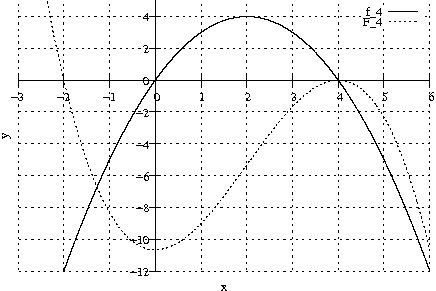0.0.1 ↑ 18. Hausaufgabe
0.0.1.1 ↑ Analysis-Buch Seite 70, Aufgabe 33
Gegeben sind die Funktionen
\mathrm{p}\colon x \mapsto \mathrm{p}(x) := -\frac{1}{2}\left(x - 3\right)^2 + \frac{9}{2}; \quad D_{\mathrm{p}} = \mathds{R};
\mathrm{g}_a\colon x \mapsto \mathrm{g}_a(x) := ax; \quad D_{\mathrm{g}_a} = \mathds{R}; \quad a \in \mathds{R};
- a)
Berechne den Inhalt A der Fläche, die von der Parabel und der x-Achse eingeschlossen ist.
\mathrm{p}(x) = 0; \Rightarrow -\frac{1}{2}x^2 + 3x = 0;
⇒ x_1 = 0; \quad -\frac{1}{2}x_2 = -3; \Rightarrow x_2 = 6;
⇒ \mathrm{p}(x) = -\frac{1}{2}x\left(x - 6\right);
⇒ VZW von - nach + bei 0 und von + nach - bei 6;
⇒ A = \int\limits_0^6 \mathrm{p}(x) \,\mathrm{d}x = \left[-\frac{1}{6}x^3 + \frac{3}{2}x^2\right]_0^6 = 18;
- b)
Berechne die Koordinaten der Punkte P und Q, in denen sich G_{\mathrm{p}} und G_{\mathrm{g}_a} schneiden.
\mathrm{p}(x) = \mathrm{g}_a(x); \Rightarrow -\frac{1}{2}x^2 + 3x = ax;
⇒ x_3 = 0; \quad -\frac{1}{2}x_4^2 + \left(3 - a\right) = 0; \Rightarrow x_4 = 6 - 2a;
⇒ P(0,0); \quad Q(6-2a, 6a-2a^2);
- c)
Berechne den Inhalt B(a) der Fläche, die zwischen G_{\mathrm{p}} und G_{\mathrm{g}_a} liegt.
\renewcommand{\arraystretch}{2.0}\begin{array}{rcl} {} \mathrm{B}(a) &:=& \left| \int\limits_0^{6-2a} \mathrm{p}(x) \,\mathrm{d}x - \int\limits_0^{6-2a} \mathrm{g}_a(x) \,\mathrm{d}x \right| = \biggl| \left[-\frac{1}{6}x^3 + \frac{3}{2}x^2\right]_0^{6-2a} - \left[\frac{a}{2}x^2\right]_0^{6-2a} \biggr| = \\ {} && \left|-\frac{1}{6}\left(6-2a\right)^3 + \frac{3}{2}\left(6-2a\right)^2 - \frac{a}{2}\left(6-2a\right)^2\right| = \left(6-2a\right)^2 \left|-1 + \frac{1}{3}a + \frac{3}{2} - \frac{a}{2}\right| = \\ {} && \left| \frac{1}{12} \left(6-2a\right)^3 \right| = \frac{2}{3} \left|3-a\right|^3; \end{array}
- d)
Für welchen Wert von a liegt zwischen G_{\mathrm{p}} und G_{\mathrm{g}_a} keine Fläche? Welche besondere Lage hat dann G_{\mathrm{p}} zu G_{\mathrm{g}_a}?
\mathrm{B}(a) = 0; \Rightarrow 3 - a = 0; \Rightarrow a = 3;
G_{\mathrm{g}_a} ist dann Tangente von G_{\mathrm{p}} an der Stelle 0. (Beweis: \mathrm{g}_3'(0) = \mathrm{p}'(0);)
- e)
Eine Gerade durch den Ursprung geht durch den Scheitel der Parabel; diese Gerade zerlegt die Fläche A von a) in zwei Teilflächen. Berechne das Verlältnis: größere Teilfläche durch kleinere Teilfläche.
\mathrm{p}'(x_5) = 0; \Rightarrow x_5 = 3; \quad \mathrm{p}(3) = 9;
\mathrm{u}(x) := \frac{\mathrm{p}(3)}{6}x = \frac{3}{2}x;
⇒ \dfrac{A - \left(\int\limits_0^3 \mathrm{p}(x) \,\mathrm{d}x - \int\limits_0^3 \mathrm{u}(x) \,\mathrm{d}x\right)}{\int\limits_0^3 \mathrm{p}(x) \,\mathrm{d}x - \int\limits_0^3 \mathrm{u}(x) \,\mathrm{d}x} = \dfrac{A}{9 - \frac{27}{4}} - 1 = 7;
- f)
Für welchen Wert von a ist \mathrm{B}(a) achtmal so groß wie die Fläche zwischen der Parabel und der x-Achse?
\mathrm{B}(a) = 8 A; \Rightarrow \frac{2}{3}\left|3 - a\right|^3 = 8 A; \Rightarrow \left(3 - a\right)^3 = \pm 12 A; \Rightarrow a = 3 - \sqrt[3]{\pm 12 A} "=" 3 - \sqrt[3]{\pm 216} "=" 3 - \pm 2 \cdot 3; \Rightarrow a_1 = -3; \quad a_2 = 9;
- g)
\int\limits_c^x \mathrm{p}(t) \,\mathrm{d}t =: \mathrm{I}_c(x);
Berechne die Integralfunktion \mathrm{I}_c von p.
\mathrm{I}_c(x) = \int\limits_c^x \mathrm{p}(t) \,\mathrm{d}t = \left[-\frac{1}{6}x^3 + \frac{3}{2}x^2\right]_c^x = \frac{1}{6}\left(-x^3 + 9x^2 + c^3 - 9c^2\right);
- h)
Für welche Werte von c ist \mathrm{I}_c symmetrisch zum Koordinatensystem?
\mathrm{I}_c(x) = \mathrm{I}_c(-x); \Rightarrow -1 = 0;
\mathrm{I}_c(x) = -\mathrm{I}_c(-x); ⇒ (Keine von x unabhängige Aussage)
⇒ Es gibt kein c \in \mathds{R}, für welches \mathrm{I}_c symmetrisch zum Koordinatensystem ist;
- i)
Für welche Werte von c geht \mathrm{I}_c durch den Ursprung?
\mathrm{I}_c(0) = 0; \Rightarrow -x^3 + 9x^2 + c^3 - 9c^2 = 0;
⇒ c_1 = 0; \quad c_2 - 9 = 0; \Rightarrow c_2 = 9;
0.0.1.2 ↑ Analysis-Buch Seite 72, Aufgabe 61
\mathrm{f}_a(x) := -\frac{4}{a^2}\left(8 - a\right)\left(x^2 - ax\right); \quad D_{\mathrm{f}_a} = \mathds{R}; \quad a \neq 0;
- a)
Bestimme den Flächeninhalt \mathrm{A}(a) der Fläche zwischen G_{\mathrm{f}_a} und der x-Achse.
\mathrm{f}_a(x) = 0; \Rightarrow x^2 - ax = 0;
⇒ x_1 = 0; \quad x_2 - a = 0; \Rightarrow x_2 = a;
⇒ \mathrm{f}_a(x) = -\frac{4}{a^2}\left(8 - a\right) \cdot x\left(x - a\right);
\mathrm{A}(a) = \left|\int\limits_0^a \mathrm{f}_a(x) \,\mathrm{d}x\right| = \biggl|-\frac{4}{a^2}\left(8 - a\right)\left[\frac{x^3}{3} - \frac{a}{2}x^2\right]_0^a\biggr| = \dfrac{2}{3}\biggl|\left(8 - a\right) a\biggr|;
- b)
Für welche a ist der Inhalt der Fläche \mathrm{A}(a) gleich 8?
\mathrm{A}(a) = 8; \Rightarrow \frac{2}{3}\left(8 - a\right)a = \pm_1 8; \Rightarrow \left(8 - a\right)a = \pm_1 12; \Rightarrow -a^2 + 8a \mp_1 12 = 0;
⇒ a_{1,2,3,4} = \dfrac{-8 \pm_2 \sqrt{64 + 4 \cdot \mp_1 12}}{-2} = \dfrac{-8 \pm_2 4\sqrt{4 \mp_1 3}}{-2} = 4 \mp_2 2\sqrt{4 \mp_1 3};
⇒ a_1 = 2; \quad a_2 = 6; \\ ⇒ a_3 = 4 + 2\sqrt{7}; \quad a_4 = 4 - 2\sqrt{7};
(Kontrolle durch Einsetzen in Anfangsgleichung beweist Korrektheit.)
Es gibt aber kein globales Maximum, da \mathrm{A}(a) \to \infty für a \to \pm\infty.
- c)
Bestimme a so, dass \mathrm{A}(a) möglichst groß wird. Gib den maximalen Flächeninhalt an.
\frac{\mathrm{d}}{\mathrm{d}a} \mathrm{A}(a) = \operatorname{sgn}\!\left(\frac{2}{3}\left(8-a\right)a\right) \cdot \frac{2}{3}\left(8 - 2a\right) = 0; (für a \neq 0)
⇒ 8 = 2a_5; \Rightarrow a_5 = 4; (VZW gegeben)
\mathrm{A}(4) = \frac{32}{3};
- d)
\mathrm{F}_4(x) := \int\limits_4^x \mathrm{f}_4(t) \,\mathrm{d}t;
Bestimme den Term \mathrm{F}_4(x) und alle Nullstellen von \mathrm{F}_4.
\mathrm{F}_4(x) = \int\limits_4^x \mathrm{f}_4(t) \,\mathrm{d}t\int\limits_4^x \mathrm{f}_4(t) \,\mathrm{d}t = -\frac{1}{3}x^3 + 2x^2 - \frac{32}{3};
Nullstellen: \mathrm{F}_4(x) = 0; \Rightarrow x_3 = -2; \quad x_4 = 4;
- e)
Berechne die Hoch-, Tief- und Wendepunkte von \mathrm{G}_{\mathrm{F}_4}.
\mathrm{f}_4(x) = -x\left(x - 4\right);
⇒ VZW von \mathrm{f}_4 von - nach + bei 0 und von + nach - bei a;
⇒ P_{\text{HOP}}(4, 0);
⇒ P_{\text{TEP}}\!\left(0, -\frac{32}{3}\right);
\mathrm{f}_4'(x) = 4 - 2x = -2 \left(x - 2\right);
⇒ VZW von \mathrm{f}_4' von + nach - bei 2;
⇒ P_{\text{WEP}}\!\left(2, -\frac{16}{3}\right);
- f)
Skizziere G_{\mathrm{f}_4} und G_{\mathrm{F}_4} in ein und demselben Koordinatensystem.

"Und das kann man zweimal unterstreichen, wenn das einen befriedigt"
"[Jeder ist] defizitär"
"Mei' Doofheit hat halt keine Grenzen"